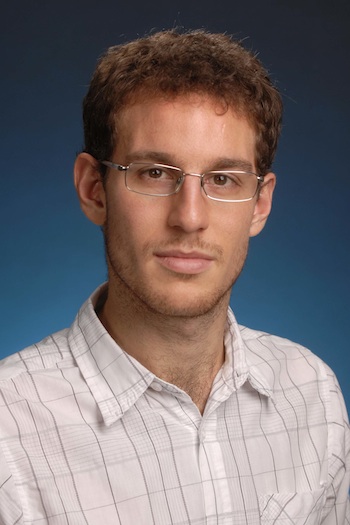Mathematician Alessio Figalli, who recently received one of Europe's highest honors, has been solving difficult mathematical problems at a prodigious clip.
 When Alessio Figalli was named one of the winners, in June 2012, of the prestigious European Mathematical Society (EMS) prize, his first reaction was gratitude for winning the prize, which is awarded every four years to 10 young European mathematicians who’ve made outstanding contributions to their field.
When Alessio Figalli was named one of the winners, in June 2012, of the prestigious European Mathematical Society (EMS) prize, his first reaction was gratitude for winning the prize, which is awarded every four years to 10 young European mathematicians who’ve made outstanding contributions to their field.
Figalli’s second thought was that it was a good day for Italy, since among the other prize-winners was another native of the country.
“Before us there was only one other Italian in the history of the prize, so we tripled our numbers,” said Figalli, a professor of mathematics at The University of Texas at Austin.
His third thought was that having two Italian winners and no winners from Spain was a bit of compensation, since only the day before his beloved Italian national soccer team had been thumped 4-0 by the Spanish in the UEFA European Football Championship.
“The day after the EMS prize announcement there was an Italian blog that ran a headline that said, ‘Italy Defeats Spain 2-0.’ Of course it would have been better if we’d won at football too.”
That Figalli reacts so humbly and humorously to a major prize—many past EMS prize-winners have gone on to win the Fields Medal, which is highest distinction in the world for mathematicians under the age of 40—is evidence, first, of his humility and sense of humor.
“He’s just a great guy, a wonderful colleague, and someone who does a lot in the department,” said Alan Reid, chair of the Department of Mathematics and Pennzoil Company Regents Professor in Mathematics.
It is also, however, evidence of how commonplace such recognition has become in the short time Figalli has been on the planet. He earned his Ph.D. at the age of 23. By the following year he was a tenured professor at the Ecole Polytechnique outside Paris. In 2009, he came to The University of Texas at Austin as a tenured associate professor, and for the academic year 2009-10 held one of the university's prestigious Donald D. Harrington Fellowships. In 2011, at the age of 27, he was named a full professor.
Along the way there have been a succession of prizes. The most recent, before the EMS prize, was the Peccot-Vimont Prize 2011 of the College of France, which is given every year to one or two mathematicians under the age of 30 who have obtained outstanding results in pure or applied mathematics.
Figalli, in other words, is a bit of a rock star.
“The guy is just an ace problem solver,” said Reid. “He works on very difficult problems, things people have been struggling with for a long time, and brings novel solution to them.”
The work for which Figalli has been most recognized is in two areas of mathematics: the optimal transport problem and a version of what’s known as Dido’s problem.
The optimal transport problem consists in finding the “cheapest” way of transporting a distribution of mass from one place to another.
“Assume you have a certain amount of soil to extract from the ground and transport to places where it should be incorporated in a construction,” Figalli explained. “The places where the material should be extracted, and the ones where it should be transported to, are all known. But the assignment has to be determined: To which destination should one send the material that has been extracted at a certain place? Proving mathematically that such an optimal transport exists and is unique has been a very nontrivial task, which has taken more than 200 years.”
 Figalli’s research has tackled a three-dimensional version of the problem, which involves trying to understand how particles in a cloud might move over time.
Figalli’s research has tackled a three-dimensional version of the problem, which involves trying to understand how particles in a cloud might move over time.
“Say you have a cloud in two configurations,” he said. “The first is at time t, and the next is a very short time later, at time t + T. It’s the same collection of particles, but they’re distributed in a different way. We’re trying to understand how the particles moved to get from the first to the second state. What was their optimal route?”
About 15 years ago meteorologists and mathematicians first succeeded in describing this problem, in mathematical terms, for particular physical regimes. It was Figalli and his collaborators, however, who proved the existence of a solution to the problem. That solution may enable scientists who study complex climate phenomena to improve their models.
The other area in which Figalli has distinguished himself has its roots in the history (and mythology) of Figalli’s hometown of Rome.
In technical circles the problem is known as the isoperimetric problem, and it deals with how to enclose the maximum amount of area given a line of a certain perimeter. More commonly it’s known as Dido’s problem, and is named after the queen of Carthage who had a small but memorable role in Virgil’s The Aeneid.
As the story goes Dido fled the city of Tyre after her brother murdered her husband. With a few of her servants she sailed across the Mediterranean and landed in the realm of King Iarbas, from whom she sought to buy a piece of land where she and her servants could live. The king offered her what he thought was a raw deal where, for her money, she could have as much land as she could enclose with a single oxhide.
Dido cut the oxhide into incredibly thin strips. By sewing the strips together she was able to enclose the largest possible area—which became the heart of Carthage—by laying the tied-together strips in a semi-circle up against the coast.
“On the coast the semi-circle is optimal,” said Figalli. “If you’re in the interior, you would enclose a round disc, a circle. That’s the two-dimensional version.”
In three dimensions, which is where Figalli has been working, the question becomes how to capture the largest possible volume with a fixed surface area.
“We know that it’s a sphere,” said Figalli. “You see it with soap bubbles, for instance, which optimize for the least area in order to minimize the surface tension. But to get from knowing it to proving it mathematically can be very tricky. What does ‘volume’ mean? What does it mean for a ‘minimum’ to exist? Exist among whom? What are the sets you are including it within?”
The final work on that problem was done in the 1950s by Ennio de Giorgi, another Italian mathematician. Figalli has been working on a variant of the problem, which involves understanding how the optimal shapes of crystals change as a function of adding energy to them.
“You give these crystals energy—heat for example—and the crystal starts to change shape,” he says. “Now you want to understand based on the heat how much the shape can change.”
Among other things, Figalli and his collaborators identified an optimal estimate for the change in the shape of a given crystal as a function of the amount of energy poured into it. This work, like the optimal transport work, may prove to have practical applications. That’s not what drives Figalli, however.
“For me the cool part is the problem itself,” said Figalli. “I’m more of a math nerd. But it is nice to know that people will use my work.”

















Comments